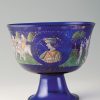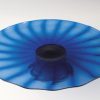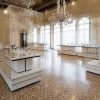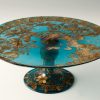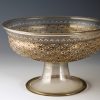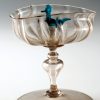MIDDLE AGES AND RENAISSANCE
The art of Venetian glass was a result of very close ties with the Middle East, with Syria in particular, whose sophisticated and elegant glass work was renowned in the Middle Ages.
This was copied by the first Venetian glass makers who also imported some of the raw materials from that area for their production. By the fourteenth century Venetian glass production was already well underway, with at least twelve glassworks that were producing everyday objects such as inghistere, long-necked bottles with onion-shaped bodies, such as the one on display.
However, it was not until the middle of the fourteenth century that Venice, who played a role in the decline of Islamic production, became the unrivalled leader in the art of glass. A decisive factor in this turning point was the invention of clear glass by Angelo Barovier (1405-1460) from Murano: for the first time in history glass was transparent, completely pure and like rock crystal. The result was instant renown for Barovier and Murano.
Decorated with fusible multicoloured enamels, their transparent glass works were in great demand with families, doges, and even the pope (as can be seen by the coat-of-arms on some of the items on display here). Some of the decorations revived motifs from the Renaissance iconography such as the famous blue Barovier drinking cup from around 1470; others limit themselves to bands of enamelled dots that are sometimes arranged in close semicircles (imbricates).
In the sixteenth century Murano glass production took on all the characteristics of pure virtuosity, some of which also involved the complex ‘flying hand’ technique – in other words, free hand, a technique that is still used by Murano glass masters today.
It was in this period that the use of pure, transparent crystal prevailed, creating uniquely harmonious and refined glasses in which they experimented new decorative techniques. One of these was diamond point engraving, which had already been used in Roman times and was reintroduced in Murano (1534-47) by Vincenzo d’Angelo dal Gallo, and produced elegant works that looked like lace. Cold painting was also experimented with, applied on the reverse of objects with themes that were inspired by artists of that time.
SIXTEENTH AND SEVENTEENTH CENTURY: INVENTIONS AND VIRTUOSITY
New types of glass were also invented in the sixteenth century however, and on display here are numerous examples of great value: iced glass, with a rough external surface, translucent, created by immerging the hot, unfinished piece in cold water and above all, filigree, one of the most fascinating creations from Murano. Invented by Filippo Catani della Sirena (or Serena) around 1527, it is made by incorporating glass rods with thin threads of white (milk glass) or coloured glass into the crystal in different ways, in either parallel or interwoven bands.It is a highly complex operation and is still extremely popular today.
These sixteenth century inventions were still produced in the following century, when the style of the Murano glass makers tended towards more bizarre forms that had a prevalently decorative function, in which the glass makers’ skill stood out: eccentric animal-shaped chandeliers, vases, cruets and glasses in the form of a flower decorated with wings, crests, dentation, tracery and threads.
The invention of aventurine, on the other hand, dates back to the seventeenth century; this was a special vitreous paste that was used as a hard stone and was extremely difficult to create, so much so that from then on until the end of the nineteenth century, the technique to create it was lost more than once.
Towards the end of the century the first examples of “feather-shaped” decoration appeared on glass; these were created by wrapping “combed” milk glass threads into festoons using a special instrument. The seventeenth century was also the century when the Murano glass makers emigrated, going abroad to work à la façon de Venise; this was also a result of the severe financial crisis that had struck the city, in particular after the plague in 1630; in addition, Bohemian glass had begun to appear on the markets in the 1670s/1680s.
However, the Murano glass makers enjoyed considerable renown in Europe: from the sixteenth century on, there were actual dynasties of glass makers. In addition to the names Barovier, dal Gallo and Serena mentioned earlier, others included Ballarin, Bortolussi, Dragani, Mozetto and Della Pigna.
It is to them and all the other great masters who made Murano so famous worldwide that this room is dedicated, with both emotion and gratitude.



